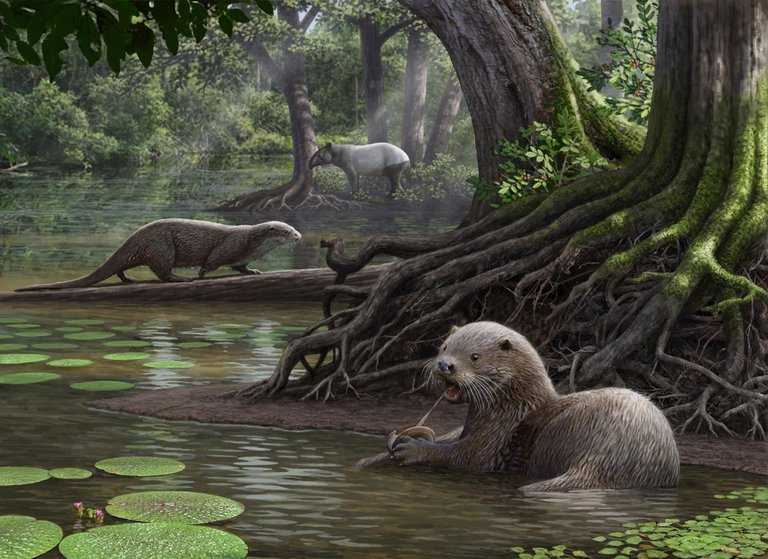
Cute, cuddly and covered in soft brown fur, otters look like teddy bears that can swim. But travel back six million years to the wetlands of southwestern China, and there roamed an ancient relative to these creatures that was more fearsome than adorable.
Known as Siamogale melilutra, this newly discovered extinct otter was about the size of a wolf and had strong-looking jaws. A team of scientists from China and the United States described the new species based on a cranium, a mandible and some teeth they found in a coal mine.
“It’s huge, it’s bigger than anything I’ve ever seen in terms of otters,” said Denise Su, the curator and head of paleobotany and paleoecology at the Cleveland Museum of Natural History and an author of the paper that appeared Sunday in The Journal of Systematic Paleontology.
Many otters today, like the marine otter or North American river otter, are about the size of a small dog. Some, like the sea otter or giant river otter, can grow to more than 75 pounds. But none are as large as S. melilutra was; the team thinks the otter measured about six feet long from snout to the tip of the tail and weighed about 110 pounds.
The key to figuring out how big the extinct otter was came from the fossil of its cantaloupe-size cranium. But when the team found the skull, special steps had to be taken to unlock its secrets.

“It was squashed flat like a pancake because of the fossilization process,” Dr. Su said. “But we were lucky because it just sat there.”
She said all the pieces were still there, the breaks were clean and the edges fit well with each other, so essentially what they had was a deflated cranium. To “inflate” it, they performed a CT scan on the fossil and then digitally reconstructed it.
With their visualization of the head, they could extrapolate how big the body was by comparing its proportions with that of modern otters.

The researchers aren’t sure why the otter was so big. But they noticed during their examination that its teeth may have been useful for crushing prey. Xiaoming Wang, curator and head of vertebrate paleontology at the Natural History Museum of Los Angeles County and lead author of the study, thinks it may have something to do with the large mollusks that shared its swamp.
He speculated that the otter might have mostly preyed on the clams and shellfish, rather than on the large land animals that lived in the area. Being large would have been evolutionarily advantageous for a creature that had to crush through hard shells for food. In the future the team will test how powerful the otter’s jaws were, hoping to figure out whether the beasts were strong enough to break the large shells.
Cute, cuddly and covered in soft brown fur, otters look like teddy bears that can swim. But travel back six million years to the wetlands of southwestern China, and there roamed an ancient relative to these creatures that was more fearsome than adorable.
Known as Siamogale melilutra, this newly discovered extinct otter was about the size of a wolf and had strong-looking jaws. A team of scientists from China and the United States described the new species based on a cranium, a mandible and some teeth they found in a coal mine.
“It’s huge, it’s bigger than anything I’ve ever seen in terms of otters,” said Denise Su, the curator and head of paleobotany and paleoecology at the Cleveland Museum of Natural History and an author of the paper that appeared Sunday in The Journal of Systematic Paleontology.
Many otters today, like the marine otter or North American river otter, are about the size of a small dog. Some, like the sea otter or giant river otter, can grow to more than 75 pounds. But none are as large as S. melilutra was; the team thinks the otter measured about six feet long from snout to the tip of the tail and weighed about 110 pounds.
The key to figuring out how big the extinct otter was came from the fossil of its cantaloupe-size cranium. But when the team found the skull, special steps had to be taken to unlock its secrets.

“It was squashed flat like a pancake because of the fossilization process,” Dr. Su said. “But we were lucky because it just sat there.”
She said all the pieces were still there, the breaks were clean and the edges fit well with each other, so essentially what they had was a deflated cranium. To “inflate” it, they performed a CT scan on the fossil and then digitally reconstructed it.
With their visualization of the head, they could extrapolate how big the body was by comparing its proportions with that of modern otters.

The researchers aren’t sure why the otter was so big. But they noticed during their examination that its teeth may have been useful for crushing prey. Xiaoming Wang, curator and head of vertebrate paleontology at the Natural History Museum of Los Angeles County and lead author of the study, thinks it may have something to do with the large mollusks that shared its swamp.
He speculated that the otter might have mostly preyed on the clams and shellfish, rather than on the large land animals that lived in the area. Being large would have been evolutionarily advantageous for a creature that had to crush through hard shells for food. In the future the team will test how powerful the otter’s jaws were, hoping to figure out whether the beasts were strong enough to break the large shells.
We’re interested in your feedback on this page. Tell us what you think.



























